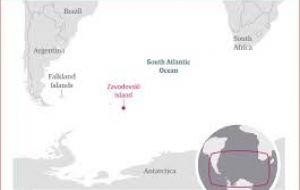MercoPress. South Atlantic News Agency
Sub Antarctic volcano eruption ash threatens one of the world's largest penguin colonies
 Molting chinstrap penguins breed on the South Sandwich Islands. Credit: Pete Bucktrout, British Antarctic Survey
Molting chinstrap penguins breed on the South Sandwich Islands. Credit: Pete Bucktrout, British Antarctic Survey  Zavodovski Island is in the South Sandwich archipelago and its volcano Mt Curry has been erupting since March 2016.
Zavodovski Island is in the South Sandwich archipelago and its volcano Mt Curry has been erupting since March 2016.  Satellite images have confirmed that between one third and one half of the island has so far been covered in ash.
Satellite images have confirmed that between one third and one half of the island has so far been covered in ash. A volcano erupting on a small island in the Sub Antarctic is depositing ash over one of the world's largest penguin colonies. Zavodovski Island is a small island in the South Sandwich archipelago and its volcano Mt Curry has been erupting since March 2016. The island is home to over one million chinstrap penguins -- the largest colony for this species in the world.
The island is part of the British Overseas Territory of South Georgia & the South Sandwich Islands and uninhabited. British Antarctic Survey (BAS) recently remapped this chain of volcanic islands and was alerted to a large (7.2) magnitude earthquake last month in the vicinity.
Researchers confirmed from satellite imagery that not one, but two volcanoes are erupting in the South Sandwich Islands. Mt Curry on Zavodovski Island to the north of the archipelago and Mt Sourabaya on Bristol Island to the south.
Following the earthquake, fishing vessels in the area licensed by the Government of South Georgia & the South Sandwich Islands, captured photos of the Zavodovski Island eruption. They show the main volcanic vent is on the western side of the island, but the prevailing wind is blowing the smoke and ash to the east, and depositing much of it on the lower slopes of the volcano. These are home to the chinstraps, closely packed in great numbers. In addition there are around 180,000 macaroni penguins.
Satellite images have confirmed that between one third and one half of the island has so far been covered in ash. At the time photos were taken, the adult chinstraps were molting, shedding their old feathers for new ones and therefore unable to leave the island.
Geographer Dr Peter Fretwell from BAS who was involved in the remapping of the archipelago says: “We don't know what impact the ash will have on the penguins. If it has been heavy and widespread it may have a serious effect on the population. It's impossible to say but two scientific expeditions are scheduled to visit the region from later this year and will try to assess the impact of the eruption.”
Penguin ecologist Mike Dunn from BAS says, “As the images were captured during the molt period for the chinstraps, the consequences could be very significant. When the penguins return to breed later in the year, it will be interesting to see what impact this event has on their numbers.”




Top Comments
Disclaimer & comment rules-

-

-

Read all commentsAll efforts must be made to save them.
Jul 07th, 2016 - 12:46 pm 0@1 Don't even think about asking for some assitance and help in Argentina...as British and Islanders usually does when needing help in the South Atlantic.
Jul 07th, 2016 - 06:18 pm 0This time nobody can mention “humanitarian” reasons...they are “your” penguin and “your” islands !!!!
@2 Evidence to support your claim? No. I didn't think so.
Jul 07th, 2016 - 08:22 pm 0Commenting for this story is now closed.
If you have a Facebook account, become a fan and comment on our Facebook Page!